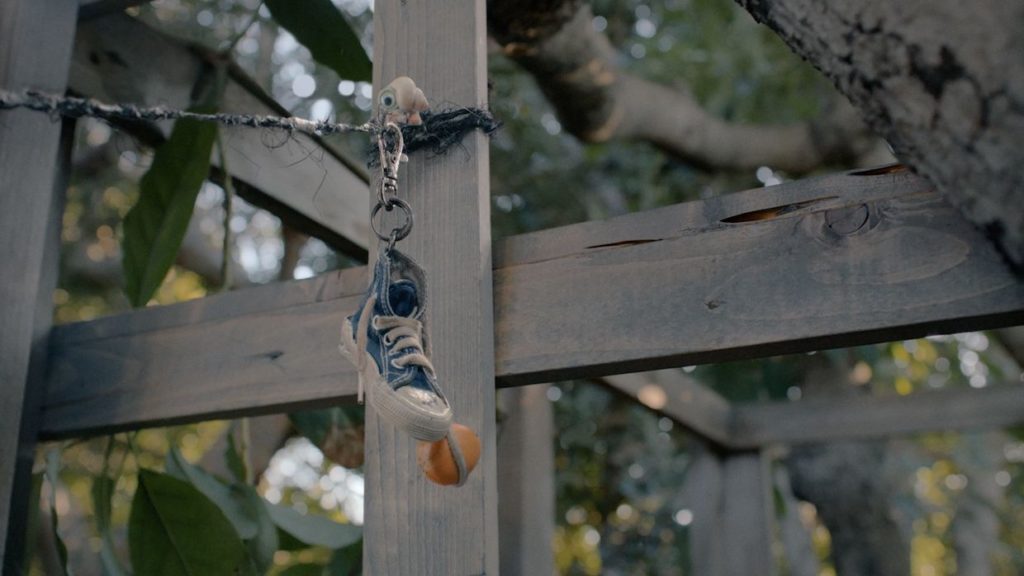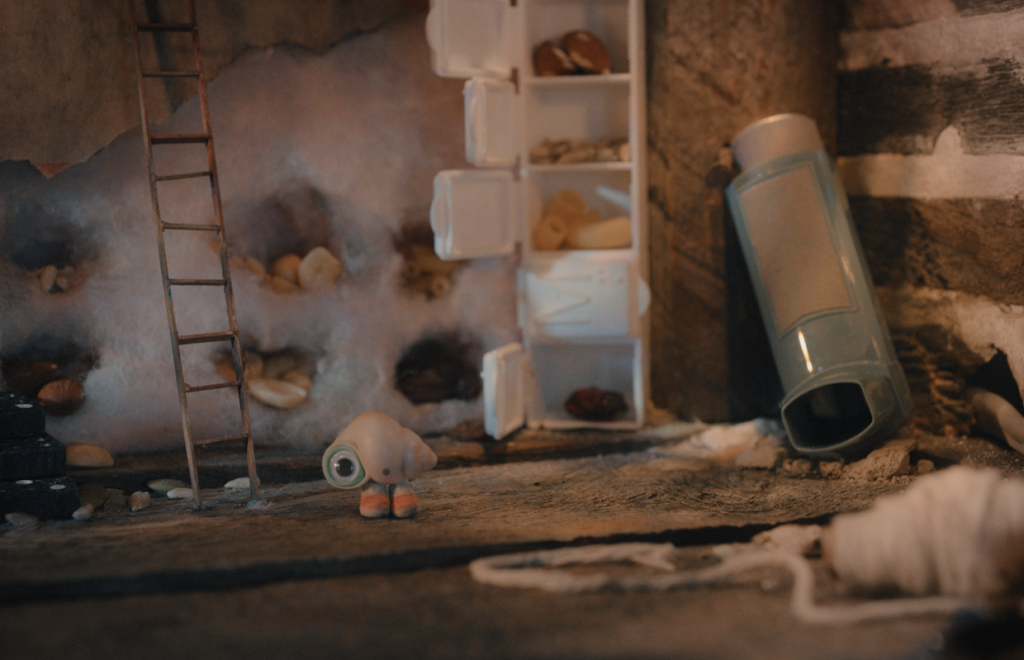 Back to selection
Back to selection
Shutter Angles
Conversations with DPs, directors and below-the-line crew by Matt Mulcahey
When A Wide Shot is 12 Inches from the Lens: DPs Bianca Cline and Eric Adkins on Marcel the Shell with Shoes On
 Marcel the Shell with Shoes On
Marcel the Shell with Shoes On There’s a saying that a movie is made three times: once when it’s written, once when it’s shot and once when it’s edited. To create the new A24 release Marcel the Shell with Shoes On, that maxim had to expand to accommodate an additional creative cycle.
Marcel, the story of a chatty one-inch tall seashell searching for his family, was in essence shot twice. First, cinematographer Bianca Cline captured the live-action components, leaving a Marcel-sized space in the compositions. Months later, armed with copious notes to match lighting, lensing, focus, etc., stop motion director of photography Eric Adkins brought Marcel to life frame by frame, so that the diminutive shell could be composited into Cline’s original photography.
With Marcel in theaters, Cline and Adkins spoke to Filmmaker about blending live action and stop motion together to create the movie’s faux-documentary aesthetic.
Filmmaker: Eric, what was the timeline of your work on the film? How long after the live action component wrapped did you get to work on the animated portion?
Adkins: I had actually shot some technical tests of live action and stop motion about a year prior [to principal photography] just to try to sell the package. Then, when we shot the live action, I was there on set with the visual effects supervisor and animation director. I would say I started preproduction[(on the animation work] three months after that. We got two weeks into shooting and the COVID lockdown happened. Four and a half months later, we resumed and did another 10 weeks. So, a total of 12 weeks of shooting [for the animation].
Filmmaker: That’s much shorter than I would’ve guessed. I did an interview with the DP of Isle of Dogs, and that was an 87-week shoot. Granted, you’re compositing into live action shots as opposed to having to create full sets for everything, but that’s still a significant disparity.
Adkins: We had a very organized shoot. We did have 15 stages, but they contained partial sets. We were keying a lot on white and gray surfaces, because in stop motion we can actually not shoot greenscreen if we want. We can make a high key alpha matte, because there’s no moving parts to it [in each individual frame]. So, we can just alternate exposures and create a backlight that has pure silhouette. We did have some sets that were full, like a windowsill or the glass tabletop for the skating sequence.
Filmmaker: The level of detail and interactivity between Marcel and his surroundings was amazing to me, even down to the shadows, which would be soft if he was in a soft source or hard if he was in a harder source, like the scene where he’s riding on the car dashboard.
Cline: That car shot was a pretty tricky one, especially filming it with a GoPro. We just drove around, then picked out the best portions for shadows and sunlight and such and Eric had to match to that.
Adkins: We looked at Bianca’s shots and analyzed each frame to be able to say, “Oh, the car is going into a daylight fill here for a long period, then here’s a dapple of light, then all of a sudden we are in the broad sunlight with an arcing bend.”
Cline: The trickiest thing from my end for that scene was how to photograph something as small as Marcel that close with a GoPro. We did a bunch of tests to figure it out. Those cameras are not designed for being up close, so we had to get macro adapters, like tiny diopters, that we could put on the GoPros. When those cameras are that close to something you also see a lot of jiggle. We had to use three of the suction cup [mounts] to hold the camera. GoPros are really meant for wide-angle action photography, to be far away from people. So, trying to make them work for this and make it feel like we’re filming [Marcel in close shots like you would a human] was difficult. That was always kind of a theme on the movie. Even though Marcel is one-inch tall, how do we photograph him so he feels like a five-foot-tall person would in the frame?
Filmmaker: Bianca, did you have some sort of Marcel stand-in on set for framing and lighting reference?
Cline: We had the actual Marcel. There were like a dozen of them. For the car scene, we used Butyl to stick him in place and would drive around with him so we had a reference for what the light would look like. In most scenes, we would use Marcel in the frame as a reference to figure out where we wanted focus to be, then do the shot again without Marcel so we had a clean frame.
Filmmaker: How much does the degree of difficulty go up when you add in zooms, focus racks and even handheld camera?
Adkins: Bianca was so great in understanding what our needs were and listening. It was an open forum and I really appreciated working with her. She nailed these amazing focus shots, knowing we needed a certain duration of time where Marcel was going to be at a certain spot on a surface with a certain depth of field.
Cline: This is supposed to be a documentary about this little character and you want it to feel a little bit uncontrolled. We wanted the handheld to feel very off the cuff, but in reality we were working within very specific parameters. We knew what would be difficult to replicate in stop motion and what wouldn’t. We also wanted the lighting to feel uncontrolled in the way that it would in a documentary. We tried to put things into it that made it feel kind of haphazard so that it didn’t feel like it was all created in a studio, which is what most stop motion ends up being. It is normally super controlled, so it ends up feeling super controlled.
Filmmaker: How did you decide on what cameras and lenses to use, since the live action portions would be shot on digital cinema cameras and the stop motion animation would be done with stills cameras?
Cline: We did tests with a bunch of different cameras to figure out which had the look that we wanted. We ended up on the older Alexa. We wanted everything to feel somewhere in between heightened and magical and the feeling of a documentary. A lot of the cameras we tested were a little bit too sharp for what we were thinking. The Alexa was soft enough, but also had the feeling of heightened reality of Marcel. For the lenses, we also wanted a softer, older feel, but with a little bit of falloff and aberrations and imperfections. We found a set of lenses that we really loved the look of. They were old, rehoused Nikon still lenses. A lot of them had seven to nine inches close focus, which we needed because the camera had to be very physically close to Marcel.
Adkins: That’s a great segue because Bianca picked those lenses and they just happen to be the lenses we traditionally shoot stop motion with—Nikor glass. It enabled us to match lenses well, at least for field of view. With that in mind, we shot with multiple Canon R still cameras, which is a mirror-less camera.
Filmmaker: When I’ve done stop motion interviews in the past, Dragonframe was the software that always seemed to come up. Is that something you used on Marcel?
Adkins: We did. We also used a lot of Kuper Control rigs in addition to Dragonframe for motion control. There used to be a bunch of different low-end capture software programs that allowed you to shoot stop motion with a tethered camera. The creator of Dragonframe, Jamie Caliri, who created the software with his brother [Dyami], was an art director on Coraline, so he knew exactly what wasn’t working with the old systems. So, now we have software that has DMX control for lighting. It can run the motion control. There’s been a lot of good advances where our needs have been met along the way.
Filmmaker: What was the most difficult shot for each of you to accomplish?
Adkins: The sofa pullback [in which dozens of animated Marcel-size creatures leap off the couch] was pretty elaborate. The most difficult concept on the movie was the fact that no matter how many notes you take, no matter how many reference photos and measurements you do, you have to know when to leave those facts behind and go with intuition and what works for the shot as long as it is perceptively correct.
Cline: Filming a character who has to be seven or eight inches from the lens added a whole bunch of complications. A wide shot of Marcel was like 12 inches from the lens. So, the closest you would ever get on a normal movie, that distance was our bread and butter for Marcel. Also, Marcel is so tiny that when you’re filming him on a surface like a floor, the middle of the lens on an Alexa is going to be, like, three-and-a-half inches off the ground. So, you’re looking down at him. We wanted the film to feel like it was in Marcel’s world, so we wanted to be at his head height. We ended up doing several things to solve that problem. We tried to put him on the edge of things, like standing on a table or on the edge of the couch, so that the camera could actually be at eye level with Marcel. We also ended up using a prism system a lot, like a periscope system, which meant we could get down to the height of just the lens itself, which even then wasn’t easy.
The ending shot was probably one of the trickiest things for me to figure out. We’ve moving in one shot across this concrete floor all the way up into a close-up of Marcel on the window. For that, we built a set in the [practical house location]. It was in the garage, and we built it into a laundry room and put a window right where we wanted it, because we knew the sun would be setting just outside that window. That was probably the most complicated for me.
To finish up, Eric provided a few notes about how specific Marcel shots were accomplished.

For this shot of Marcel’s friends and family watching 60 Minutes, we shot on the stop motion stage with a motion controlled tower/pull back and a widening Fujinon zoom lens.

Marcel was shot with a similar layout of wood and taut line for spatial line up, but the shoe [sliding down the line] was puppeted in the live action [shot] for interaction.

Marcel’s store room was a set that was built for shooting in the stop motion stages, filled with Source Four minis and practical strands of lights. No composite necessary.
